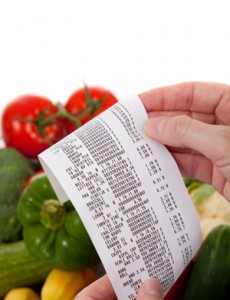Where are you most likely to encounter BPA (bisphenol A)? Water bottles? No. Think cash register receipts. Thermal paper receipts are coated with BPA to get the ink from the receipt printer to develop on the paper. The problem is that BPA does not stay on the receipt; instead, it is absorbed by anyone handling the paper.
Researchers analyzed 13 different thermal papers and found BPA in 11 of them. They found that BPA transferred “to the forefinger and the middle finger if the skin was rather dry and about 10 times more if these fingers were wet or very greasy.” This study, published in Analytical and Bioanalytical Chemistry, found that BPA transfers readily from receipts to skin and “that it can enter the skin to such a depth that it can no longer be washed off.”
Nearly every modern cash register uses this kind of paper. An Environmental Working Group (EWG) commissioned study found that the total mass of BPA on a receipt is 250 to 1,000 times greater than the amount of BPA typically found in a can of food, a can of baby formula or that which leaches from a BPA-based plastic baby bottle into its contents.
BPA is dangerous, even in small amounts. Studies link it to cancers, diabetes, heart disease, obesity and more. Canada was the first to ban the use of the chemical in baby bottles, followed by the European Union, effective June 2011. A similar measure to ban BPA in sippy cups and baby bottles was dropped from a U.S. federal food safety bill in 2010. The American effort to ban BPA was championed by Sen. Dianne Feinstein of California, but the American Chemistry Council convinced Republican senators to kill the measure.
The easiest way to avoid getting BPA on your hands is to leave the receipt behind if you do not need it. Ask the cashier not to print it, if possible. Do not use alcohol-based hand sanitizers after handling receipts — a recent study showed that these products can increase the skin’s BPA absorption.
The EWG research shows that some of the stores that use BPA-containing receipts in at least some outlets include McDonald’s, CVS, KFC, Whole Foods Market, Walmart, Safeway and the U.S. Postal Service.
According to tests done by EWG, a receipt for a McDonald’s Happy Meal™ purchased in Connecticut in April of 2010 had an estimated 13 milligrams of BPA. That equals the amount of BPA in 126 cans of Chef Boyardee® Overstuffed Beef Ravioli in Hearty Tomato and Meat Sauce.
Sources: Analytical and Bioanalytical Chemistry, Volume 398, Number 1, 571-576, Sept. 2010, www.springerlink.com/content /d5j507113141120h/ and Environmental Working Group (www.ewg.org/bpa-in-store-receipts).
Reprinted from AzNetNews, Volume 31, Number 1, Feb/Mar 2012.






March 1, 2012
Health, Health Concerns